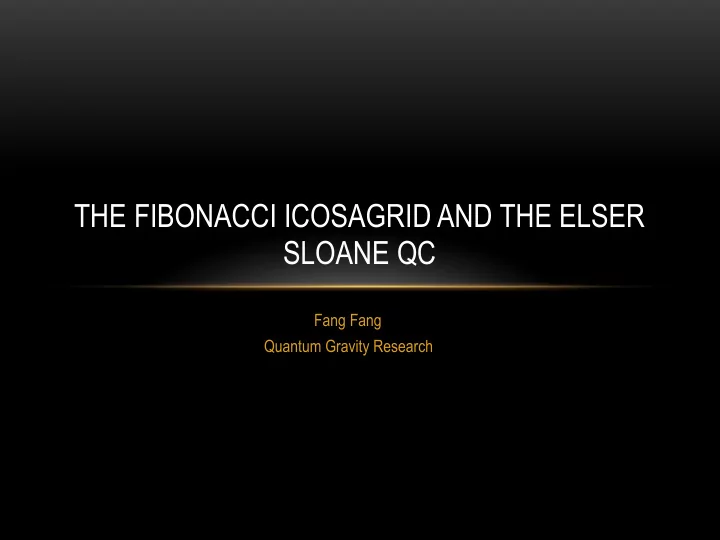

THE FIBONACCI ICOSAGRID AND THE ELSER SLOANE QC Fang Fang Quantum Gravity Research
OUTLINE • Icosagrid and Fibonacci Icosagrid • The Esler Sloane QC, 600-cell and the 600-cell compound • The 3D compound QC • The matching between the Fibonacci IcosaGrid and the 3D compound QC • Connection between the 20G twist and 600-cell compound
ICOSAGRID
ANOTHER WAY OF BUILDING THE ICOSAGRID
FIBONACCI ICOSAGRID
FIBONACCI ICOSAGRID
THE ELSER-SLOANE QC The Elser-Sloane QC is constructed in real four-dimensional Euclidean space, having the noncrystallographic reflection group [3,3,5] of order 14400 as its point group. It is obtained as a projection of the eight-dimensional lattice E8, and has as a cross-section a three-dimensional quasicrystal with icosahedral symmetry. ⎡ ⎤ Projection mapping matrix: Π = − 1 σ − 1 I H , ⎢ ⎥ 5 ⎢ H σ I ⎥ ⎣ ⎦ ⎡ ⎤ − 1 − 1 − 1 − 1 ⎢ ⎥ 5 − 1 , H= 1 1 − 1 − 1 1 where I = I 4 = diag{1,1,1,1}, σ = ⎢ ⎥ . 2 2 1 1 − 1 − 1 ⎢ ⎥ ⎢ ⎥ 1 − 1 1 − 1 ⎣ ⎦
THE ELSER-SLOANE QC Properties of this QC (Ref): • It is invariant under a point group (fixing the origin) isomorphic to G 1 = [ 3 , 3 , 5 ]. It is closed under multiplication by τ . • • It is a discrete set of points. • It has a 600-cell {3,3,5} at its center, whose 120 vertices are mapped from 120 of the 240 minimal vectors of E 8. Similarly exactly 120 of the 2160 vectors in E 8 of length 2 mapped to a slightly larger ( τ times) { 3 , 3 , 5 } concentric with the first. • It has a cross-section which is a 3-D quasicrystal with icosahedral symmetry.
THE 3D COMPOUND QC – TYPE I
THE 3D COMPOUND QC – TYPE I
THE 3D COMPOUND QC – TYPE II
THE 3D COMPOUND QC – TYPE II
WHY COMPOSE THEM TOGETHER THIS WAY? The open and closing animation of the 20Gs Match to the Fibonacci IcosaGrid Match to the 600-cell compound
THE GOLDEN TWIST AND THE CLOSING OF THE 20G TWISTS
MAPPING BETWEEN THE 3D COMPOUND QC (TYPE I AND TYPE II) AND THE FIBONACCI ICOSAGRID Fibonacci Icosagrid includes CMPD-QC type II Fibonacci Icosagrid does not include CMPD-QC type I CMPD-QC type I includes CMPD-QC Type II New Modified Fibonacci Icosagrid with Icosahedral symmetry should be able to include both CMPD-QC.
THE 600-CELL AND ITS COMPOUND (PROJECTION OF THE E8 VORONOI CELL) Each vertex of the E8 Voronoi cell corresponds to one 7- facets in the Gosset 4 21 polytope.
THE 600-CELL AND ITS COMPOUND (PROJECTION OF THE E8 VORONOI CELL)
CONNECTION BETWEEN THE 20G TWIST ( LEFT AND RIGHT SUPERPOSITION ) AND 600-CELL COMPOUND
CONNECTION BETWEEN THE 3D PROJECTION OF THE ELSER-SLOANE QC AND THE TSAI-TYPE QC
SUMMARY
ICOSAGRID
THE ELSER-SLOANE QC The Elser-Sloane QC is constructed in real four-dimensional Euclidean space, having the noncrystallographic reflection group [3,3,5] of order 14400 as its point group. It is obtained as a projection of the eight-dimensional lattice E8, and has as a cross-section a three-dimensional quasicrystal with icosahedral symmetry.
CONNECTION BETWEEN THE 3D PROJECTION OF THE ELSER-SLOANE QC AND THE TSAI-TYPE QC
Recommend
More recommend